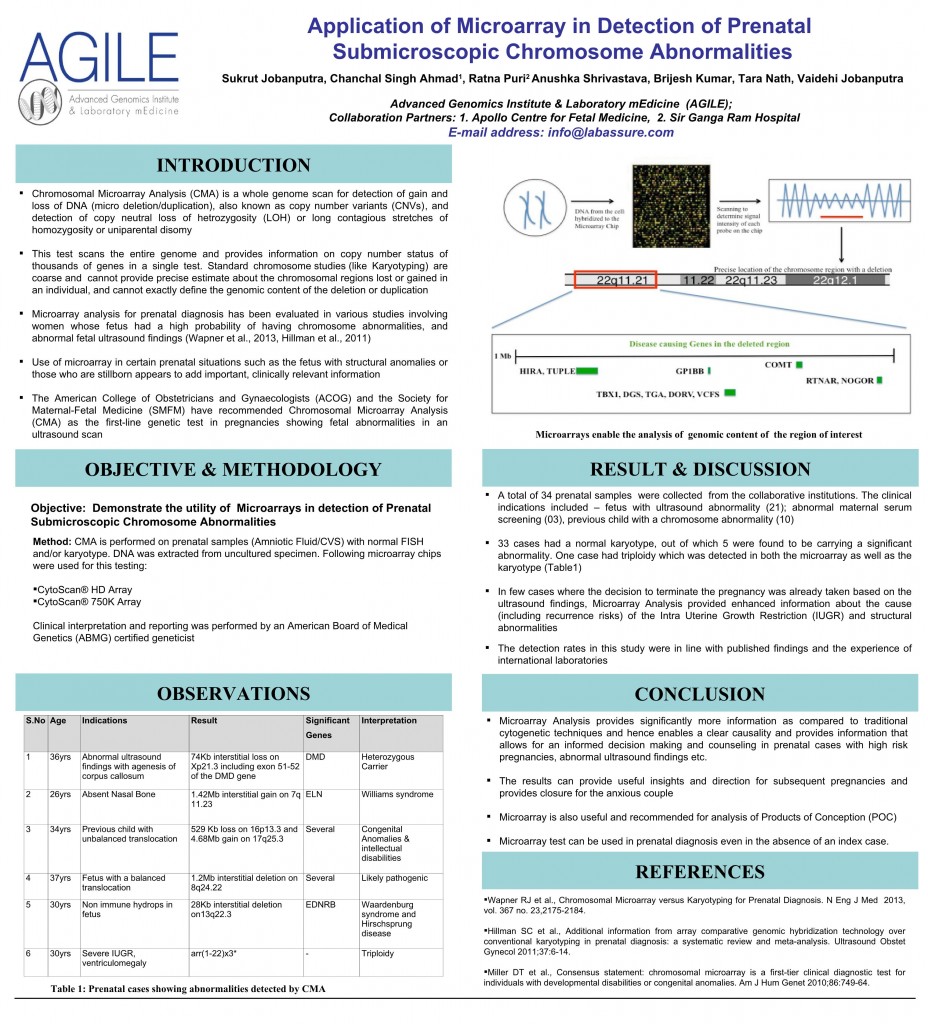Sukrut Jobanputra, Chanchal Singh Ahmad1, Ratna Puri2 Anushka Shrivastava, Brijesh Kumar, Tara Nath, Vaidehi Jobanputra
Advanced Genomics Institute & Laboratory medicine (AGILE)
Collaboration Partners: 1. Apollo Centre for Fetal Medicine, 2. Sir Ganga Ram Hospital
E-mail address: info@labassure.com
Chromosomal Microarray Analysis (CMA) is a whole genome scan for detection of gain and loss of DNA (micro deletion/duplication), also known as copy number variants (CNVs), and detection of copy neutral loss of hetrozygosity (LOH) or long contagious stretches of homozygosity or uniparental disomy. This test scans the entire genome and provides information on thousands of genes in a single test. Use of microarray in certain prenatal situations such as the fetus with structural anomalies or those who are stillborn appears to add important, clinically relevant information.
ObjectiveDemonstrate the utility of Microarrays in detection of Prenatal Submicroscopic Chromosome Abnormalities
MethodChromosomal microarray is performed on prenatal samples (Amniotic Fluid) using the following microarray chips:
1.CytoScan® HD Array
2.CytoScan® 750K Array
The arrays used included the Loss of heterozygosity (LOH) determination and detection of uniparental iso-disomy (UPD). Analysis was done using Chromosome Analysis Suite (ChAS) Software and clinical interpretation and reporting was done by ABMG certified geneticist.
ResultsA total of 34 prenatal samples were received from collaborative institutions. The clinical indications included fetus with ultrasound abnormality (21); abnormal maternal serum screening (03), previous child with a chromosome abnormality (10). Out of these 34 cases with normal karyotype, 7 were found to be carrying a significant abnormality.
ConclusionMicroarray Analysis provides significantly more information as compared to traditional cytogenetic techniques and hence enables a clear causality and provides information that allows for an informed decision making and counseling in prenatal cases with high risk pregnancies, abnormal ultrasound findings etc. In few cases where the decision to terminate the pregnancy was already taken based on the ultrasound findings, Microarray Analysis provided enhanced information about the cause (including recurrence risks) of the Intra Uterine Growth Restriction (IUGR) and structural abnormalities. Microarray test can also be used in prenatal diagnosis even in the absence of an index case & also for analysis Products of Conception. This test is of enormous practical value to patients and physicians because it provides accurate genetic information which can be used for improved diagnosis and treatment decisions.


